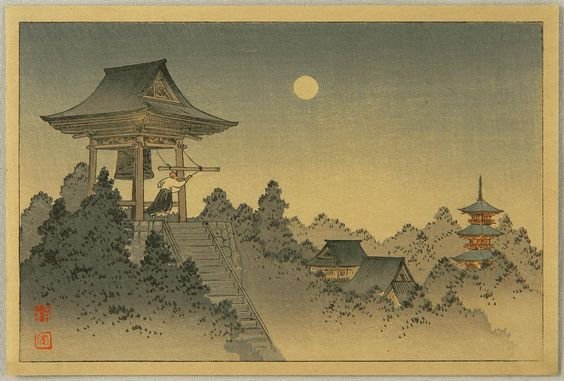【Update 2024-10-28: This is an outdated version of this article. For a more up to date version, please see: https://laspina.org/temple-bell-butterfly/ 】
tsurigane ni tomarite nemuru kocho kana
on the temple bell
sleeping
a butterfly
—Buson
(trans. David LaSpina)

(Print by Shoda Koho)
This may be Buson's most famous haiku. A few days ago, I mentioned that butterflies in haiku are often references to Chuang-tzu and questions about the nature of reality. So to here. Presumably the butterfly will wake and fly away soon enough, as soon as the surrounding quiet is broken, making his stay on the bell a temporary rest. The impermanence of life is a constant theme in Japan. It is why the cherry blossoms are so beloved, for instance, because they remind us of the shortness of life. Just as the butterfly will be woken soon from his sleep, so will we. Perhaps woken to find out that we are that butterfly?
But there is more than that going on here.
I have mentioned Heike Monogatari, The Tale of the Heike, a few times previously. It is the most famous epic in Japan, telling the story of the rise and the fall of the Taira clan (the Heike), of their head, Kiyomori, his rise and his downfall, and of the clan's eventual fall to the Minamoto (the Genji). The major theme of the story is one of impermanence. What begins, must end. The famous opening of the epic (which all schoolchildren in Japan have to memorize) sums it up:
The ring of the bells at Gion temple
echoes the impermanence of all things.
The color of the sala flowers
reveals the truth that to flourish is to fall.
The proud do not endure long
like a passing dream on a spring night.
The mighty fall at last,
like dust in the wind†
Somewhat fittingly, the family crest of the Taira was... a butterfly. Seriously. Kiyomori's dream to control Japan, like the dream of a butterfly, soon to end as soon as that bell rings, waking him.
There is a good reason why this is Buson's most famous haiku. It is doing a lot of work, leading us not only to Chuang-tzu and his dream of being a butterfly, but to Kiyomori and his dream of controlling Japan.
Footnotes:
†: Translation mine. Try not to get the Kansas song stuck in your head from that last line.
Don't miss other great haiku in the Haiku of Japan series!
#1–10 — Haiku of Japan, Collection #1
#11–20 — Haiku of Japan, Collection #2
#21 — The Thief and the Moon
#22 — My Frozen Balls
#23 — Saké Waves
#24 — Friends with the Moon
#25 — Falling Flower
#26 — Winter Rain and No Hat
#27 — Sleeping Boy
#28 — Reward of Persimmons
#29 - Chestnut Worm
#30 - Drunken Leaf Watching
#31 — Am I a Butterfly or a Man?
#32 — Hidden Grey Hair
❦
 |
David LaSpina is an American photographer and translator lost in Japan, trying to capture the beauty of this country one photo at a time and searching for the perfect haiku. He blogs here and at laspina.org. Write him on Twitter or Mastodon. |
